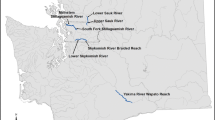Abstract
Many of the environmental problems associated with channel modifications can be anticipated if known fluvial relationships are considered early in the planning process. Plan modifications or corrective measures can be employed to prevent environmental degradation and improve project performance. The fluvial system is reviewed from a geomorphic perspective. Functional fluvial relationships are described and their use in planning and design of flood channels is demonstrated.
Similar content being viewed by others
Literature cited
Allen, J. R. L. 1977. Changeable rivers: some aspects of their mechanics and sedimentation. Page 15in K. J. Gregory (ed.), River channel changes. John Wiley and Sons, New York.
Branson, F. A. 1981. Rangeland hydrology, 2nd edn. Kendall-Hunt, Dubuque, IA.
Collier, C. R., and others. 1964. Influence of strip mining on the hydrologic environment of Beaver Creek Basin, Kentucky, 1955–1959. Professional paper 427-B, US Department of Interior, Geological Survey, Washington, DC.
Collier, C. R., and others. 1971. Influence of strip mining on the hydrologic environment of parts of Beaver Creek Basin, Kentucky, 1955–1966. Professional paper 427-C, US Department of the Interior, Geological Survey, Washington, DC.
Douglas, I. 1974. The impact of urbanization on river systems. Pages 307–317in Proceedings of the international geographical union regional conference. New Zealand Geographical Society, Christchurch.
Dunne, T., and L. B. Leopold. 1978. Water in environmental planning. Freeman, San Francisco.
Graf, W. L. 1979a. Catastrophe theory as a model for change in fluvial systems. Pages 13–32in D. D. Rhodes and G. P. Williams (eds.), Adjustments of the fluvial system. Kendall-Hunt, Dubuque, IA.
Graf, W. L. 1979b. Mining and channel response.Annals of the Association of American Geographers 69:262–275.
Hammer, T. 1972. Stream channel enlargement due to urbanization.Water Resources Research 8:1530–1540.
Janda, R. J., and others. 1975. Watershed conditions in the drainage basin of Redwood Creek, Humboldt Co., California, as of 1973. Open file report no. 75.568, US Department of the Interior, Geological Survey, Washington, DC.
Lane, E. W. 1947. The effect of cutting off bends in rivers. Pages 230–240in J. W. Howe and J. S. McNown (eds.), University of Iowa studies in engineering, proceedings of the third hydraulic conference. Bulletin 31. University of Iowa, Iowa City.
Lane, E. W. 1955. The importance of fluvial morphology in hydraulic engineering.American Society of Civil Engineers Proceedings 81:181–197.
Lull, H. W., and K. G. Reinhart. 1963. Logging and erosion on rough terrain in the east. Pages 43–47in Proceedings of the federal interagency sedimentation conference 1963. Miscellaneous publication 970. US Department of Agriculture.
Maddock, T. 1972. Hydrologic behavior of stream channels. Pages 366–374in Transactions of the 37th North American wildlife and natural resources conference, March 1972. Wildlife Management Institute, Washington, DC.
Parker, G., and D. Andres. 1976. Detrimental effects of river channelization. Pages 1248–1266in Proceedings of the symposium on inland waters for navigation, flood control, and water diversions. American Society of Civil Engineers.
Pinchot, G. 1947. Breaking new ground. Harcourt Brace, New York, p. 332.
Santos-Cayudo, J., and D. B. Simons. 1972. River response. Pages 1-1–1-25in H. W. Shen (ed.), Environmental impact on rivers. H. W. Shen, Fort Collins, CO.
Schumm, S. A. 1977. The fluvial system. John Wiley and Sons, New York.
Thornes, J. B. 1977. Hydraulic geometry and channel change. Pages 91–100in K. J. Gregory (ed.), River channel changes. John Wiley and Sons, New York.
Trimble, S. W. 1974. Man-induced soil erosion on the Southern Piedmont. Soil Conservation Society of America, Ankeny, IA.
White, W. D., and S. G. Wells. 1979. Forest fire devegetation and drainage basin adjustments in mountain terrain. Pages 199–223in D. D. Rhodes and G. P. Williams (eds.), Adjustment to the fluvial system. Kendall-Hunt, Dubuque, IA.
Wolman, M. G. 1967. A cycle of sedimentation and erosion in urban river channels.Geografiska Annaler 49:385–395.
Author information
Authors and Affiliations
Rights and permissions
About this article
Cite this article
Nunnally, N.R. Application of fluvial relationships to planning and design of channel modifications. Environmental Management 9, 417–425 (1985). https://doi.org/10.1007/BF01866340
Issue Date:
DOI: https://doi.org/10.1007/BF01866340




